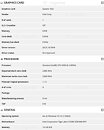- Joined
- Oct 9, 2007
- Messages
- 47,619 (7.44/day)
- Location
- Dublin, Ireland
| System Name | RBMK-1000 |
|---|---|
| Processor | AMD Ryzen 7 5700G |
| Motherboard | Gigabyte B550 AORUS Elite V2 |
| Cooling | DeepCool Gammax L240 V2 |
| Memory | 2x 16GB DDR4-3200 |
| Video Card(s) | Galax RTX 4070 Ti EX |
| Storage | Samsung 990 1TB |
| Display(s) | BenQ 1440p 60 Hz 27-inch |
| Case | Corsair Carbide 100R |
| Audio Device(s) | ASUS SupremeFX S1220A |
| Power Supply | Cooler Master MWE Gold 650W |
| Mouse | ASUS ROG Strix Impact |
| Keyboard | Gamdias Hermes E2 |
| Software | Windows 11 Pro |
An unnamed Intel "Tiger Lake-U" quad-core processor was spotted on Futuremark database by _rogame, featuring 2.80 GHz nominal clock-speeds. Barring the 28 W i7-1068NG7 and i5-1038NG7, which are exclusive for MacBooks and aren't considered U-segment, all current-gen "Ice Lake" client chips have their nominal clock speeds ranging between 1.00 to 1.30 GHz. Given this, 2.80 GHz would qualify as a big jump for a U-segment "Tiger Lake" chip. We know from a separate report that "Tiger Lake" could also offer Turbo Boost frequencies as high as 4.70 GHz for the top Core i7-1185G7 part, a similar jump from the 3.90 GHz max boost of the current-gen i7-1065G7, all while retaining a 15 W nameplate TDP.
The Futuremark database listing only mentions nominal clock of 2.80 GHz, and the CPU core configuration of 4-core/8-thread. The hardcoded CPU name string of this prototype specifies "Tiger Lake U," confirming this is a 15 W part, and not a 28 W part that will be gobbled down by Apple. Intel's newfound clock-speed headroom could be attributed to the company's refined 10 nm+ silicon fabrication node. "Tiger Lake" combines "Willow Cove" CPU cores with an iGPU based on the company's ambitious new Xe graphics architecture, marking its commercial debut. "Tiger Lake" is expected to launch around September-October, 2020.

View at TechPowerUp Main Site
The Futuremark database listing only mentions nominal clock of 2.80 GHz, and the CPU core configuration of 4-core/8-thread. The hardcoded CPU name string of this prototype specifies "Tiger Lake U," confirming this is a 15 W part, and not a 28 W part that will be gobbled down by Apple. Intel's newfound clock-speed headroom could be attributed to the company's refined 10 nm+ silicon fabrication node. "Tiger Lake" combines "Willow Cove" CPU cores with an iGPU based on the company's ambitious new Xe graphics architecture, marking its commercial debut. "Tiger Lake" is expected to launch around September-October, 2020.

View at TechPowerUp Main Site



